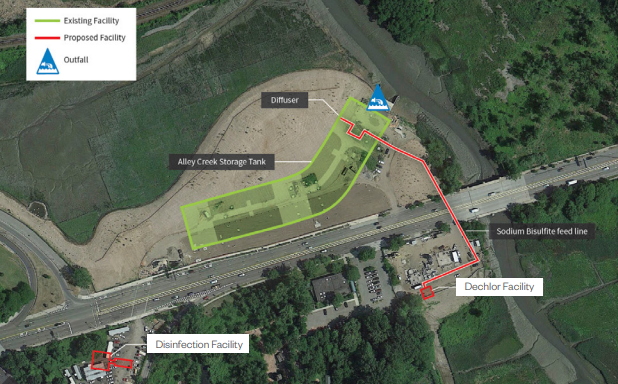
DEP
An image from the city's CSO-control plan for Alley Creek in Queens showing the proposed location for a chlorination/dechlorination facility.
Friday’s endless storm shut down both the city’s airports, threw trees across the 5 train lines in the Bronx and forced Amtrak to suspend service from Washington to Boston—highly visible manifestations of how wet weather can affect the world’s greatest city. Hidden from view was what was going on at the city’s water pollution control plants, where heavy rain can sometimes trigger the release of raw sewage into New York’s creeks, bays, canals and rivers.
That pollution occurs when older parts of the city’s sewage system, which combine rainwater and sewage, send too much wet stuff to the water treatment plants, which then kick the excess liquid to the nearest waterway. Such “combined sewer overflows” or CSOs tally up to tens of billions of gallons of untreated wastewater each year and are the major reason why most of the city’s tributaries aren’t health enough to fish, swim or boat in—the goal set by the federal Clean Water Act for every waterway in the United States.
New York City has been under federal pressure for years to address CSOs, and has spent billions reducing their impact. Led by the local Department of Environmental Protection, the city is developing Long-Term Control Plans outlining efforts to get CSOs under control at 11 city water bodies.
According to a letter (you can read it below) signed by 20 City Councilmembers and sent to the mayor this week, there is some concern about how those plans are being formulated and some of the strategies that city plans to use.
“We write to you to seek to establish a more productive and fruitful discussion around the development and implementation of the Department of Environmental Protection’s Long Term Control Plan (LTCPs) for managing New York City’s Combined Sewer Overflow (CSO) outfalls,” the letter read. It nodded to “groups and constituents who harbor grave concerns regarding how the LTCP process has been conducted to date.”
The letter doesn’t detail the concerns about the process or the steps it wants the city to take to address them. For its part, DEP has already committed to more public engagement on the LTCPs. For one thing, the agency will now let the public review final recommendations on the plans before they are submitted to the state
Where the letter does get specific is on chlorination, a major sticking point between DEP and some water-quality advocates. In a few waterways, the city wants to treat wastewater overflows with chlorine to kill fecal bacteria, and then “dechlorinate” the water to make the chemical doesn’t kill fish when it’s released into city waters. But advocates contend that such a process has never been used on this scale and poses risks.
“[W]hile chlorination of CSO overflows is a method that has been used elsewhere, the EPA has acknowledged many problematic side effects of chlorination, including its toxicity, its corrosive properties, and the potential for creating carcinogenic by-products like trihalomethanes,” the letter reads.
DEP recently met with environmental advocates about chlorination concerns, and the Councilmembers’ letter praises DEP Commissioner Vincent Sapienza for being accessible to their questions.
“We look forward to partnering with the City Council, environmental advocates and the public as we continue the important work of developing and implementing Long Term Control Plans that will improve the health of New York Harbor,” DEP told City Limits in a statement. The agency notes that for the creation of the forthcoming citywide Long-Term Control Plan, there will be nine public meetings.









One thought on “Pols Tell Mayor They’re Concerned About Clean Water Moves”
Pingback: A Sharp Rise in NYC Sewage Dumping: 1 in 3 Days « Sara D. Roosevelt Park Coalition